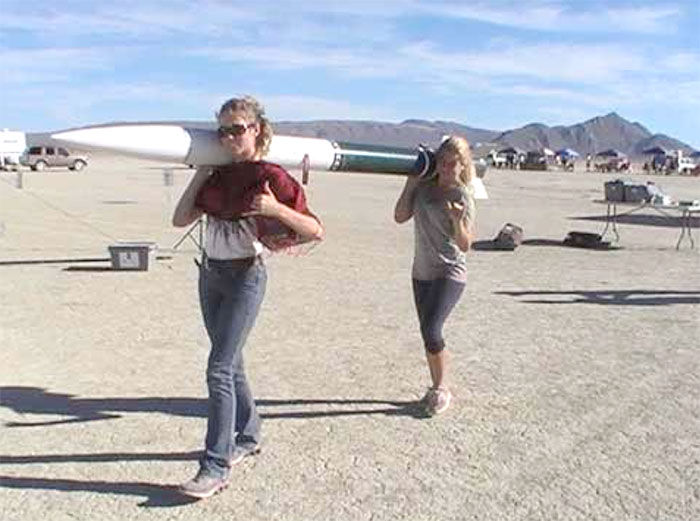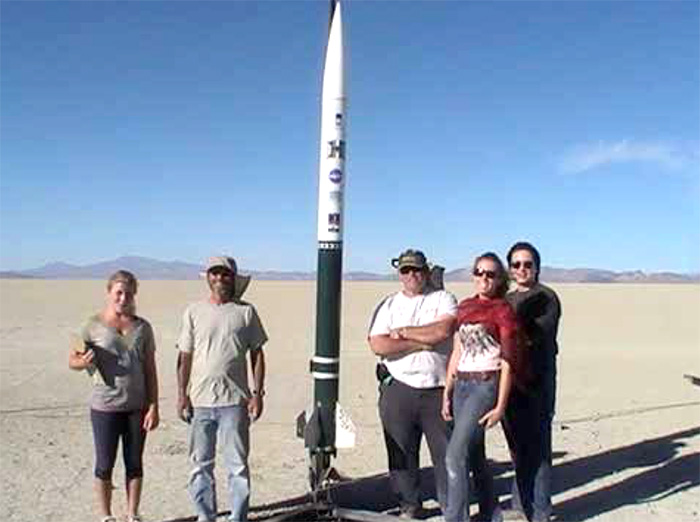ARLISS & USLI Updates
By: Windward Community College Students
Na Huakai, Vol. 4, Winter 2011

It started off as a Gentlemen's bet between two Engineering professors, Bob Twiggs of Standford University, and Shinichi Nakasuka of the Tokyo Institute for Technology. The bet was to see who had the better engineering design students. The challenge was to have their students design and build an electronic payload that in all respects was to emulate a planetary probe. The payload would have to gather atmospheric data and, either store that data on-board, or send it via telemetry to a passive ground station. The twist was that payloads would have to autonomously make their way to a specified GPS location after being deployed. How were they to determine which was the best? Have a trial by fire! The final payload projects would be put to an operational test; they would be inserted into high-powered rockets, which would then boost them to altitudes of greater then two miles up, and see which ones satisfied the mission criteria the best. Because of the limited space of the payload sections of these rockets, there was a spatial constraint imposed on the projects; they had to fit inside a cylindrical volume with a diameter of 5.8 inches, and a length of 11.5 inches. The payloads were also assigned a mass limit of 2.0 kg. And so began a lively exchange of ideas between students and a competition designed to instill the necessary skills that an engineer would need to survive in the 'real' world.
That was thirteen years ago, and was the kick-off event for ARLISS - A Rocket Launch for International Student Satellites!
For the first seven years, no team satisfied all the mission parameters. Some came close, but how close do you have to be to count? To satisfy the 'come-back' criteria, the payload had to get within 6 meters of the target, the team had to present their obtained data, and they had to show proof that the payload did indeed work to get to the target (as opposed to just falling out of the sky next to the target). The first University to win the competition was Tohoku University in 2006. Since then there have only been two other winners -- only now the prize money has blossomed from $200, offered by the betting professors, to more then $20,000 offered by private aerospace industries.
Now ARLISS has grown into a truly international affair. Last year, institutions from around the Pacific, all over the United States, some from Europe, and Windward Community College (WCC) gathered to test their electronic payloads. The annual launch, hosted by AeroPAC (the local chapter of the Tripoli High Powered Rocketry Association), takes place at Black Rock desert in Nevada. WCC has represented the Hawai‘i Space Grant Consortium at ARLISS for the last 5 years, and in 2010 came in second overall.
There are two things that make WCC's entry in ARLISS unique. The first is our strategy. Many of the participating teams make use of ground traversing technology wherein the payload is deployed from the rocket and parachutes safely to the ground. Upon landing, the cord attaching the chute is cut, and the unit then rolls to the target area. There are many pit-falls to this approach; rough terrain, hard landings, limited battery life, large cost, etc. WCC's approach has been much more basic. We make use of a steerable parasail. This approach allows a simpler design (really only one moving part) and much lower cost. Its main problems are head winds, which can blow a project as much as 17 miles off course, and chute failure. Recent WCC designs have broken the payload descent phase into two parts: a free-fall descent to 1100 feet, and then a much slower controlled descent phase after the parasail has been deployed. This year the head winds were stronger then normal, and the parasail was deployed too early in the descent of WCC's first attempt. Nevertheless, the payload got to within 1000 meters of the target. Which was close considering that several times during the controlled descent phase, the unit had to double back on itself as the winds tried to blow it in the wrong direction. The second flight was not so successful; the parasail failed to deploy and the payload impacted the playa floor.


Joleen Iwaniec and Patrick Lancaster
The second reason why the WCC team unique is that we are the only institution that not only supplies a payload project, but also supplies its own rockets as well. The ARLISS competition requires that each of the payload-carrying rockets go through a rigid inspection. Not only must it be demonstrated that the rocket can withstand the 5-g stress of launch, and is capable of carrying the payload to height, but it must also be safe. This last requires separate, but redundant chute deployments. Because of the development of a payload, and a rocket to carry it, it was suggested that the ARLISS team consider taking part in the University Student Launch Initiative (USLI). USLI tasks students to design and build a scientific payload to gather data or perform an experiement, and a rocket to take that payload to a height of one mile (no higher or lower). Additionally, students are introduced to the design protocols that NASA would require of any subcontracting entity. Students are required to submit reports for a Preliminary Design Review (PDR), a Critical Design Review (CDR), a Flight Readiness Review (FRR), and a Post Launch Assessment and Review (PLAR). This is the second year the WCC ARLISS team has entered USLI.

